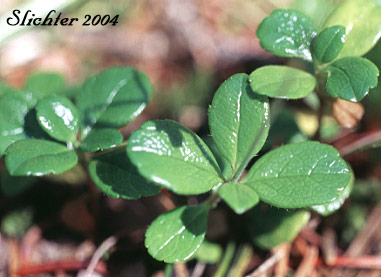 The
photo at right shows the glossy green leaves of twin flower as seen at Swampy
Meadows on the western slopes of Mt. Adams.......August 8, 2005.
The
photo at right shows the glossy green leaves of twin flower as seen at Swampy
Meadows on the western slopes of Mt. Adams.......August 8, 2005.
Twinflower is an attractive ground-cover shrub which does well in the woodland garden. The slender, woody stem creeps across the ground for distances up to a meter with upright branches from 5-20 cm long. The shiny leaves are round to obovate in shape with some teeth. They are petioled with the blades varying from 1-2 cm long.
The inflorescence consists of 2 flowers supported above the erect branches from the stem by leafless peduncles. The sepals are linear to lanceolate in shape and shorter than the corolla tube. The corolla is funnel-shaped, pinkish, and 12-15 mm long. The corolla is somewhat pubescent within. The fruit is nut-like, ovoid in shape, and glandular.
As mentioned above, twinflower is suitable for the woodland garden. Plants are available in pots from many native plant nurseries. Plants should be placed in sites with shade to partial shade and which have a fairly thick, decayed layer of leaf or conifer litter. Plants will spread up to a meter from their planting site, and are impressive in bloom.
Twin flower may be found in open to dense woods and brush at most elevations.
Twin flower may be found from Alaska south to California and east through Canada and wouth to New Mexico, Arizona, South Dakota, Indiana and West Vairginia.
In the Columbia River Gorge it may be found between the elevations of 100'- 4000' from Crown Point east to the Weldon Wagon Trail north of White Salmon, WA.